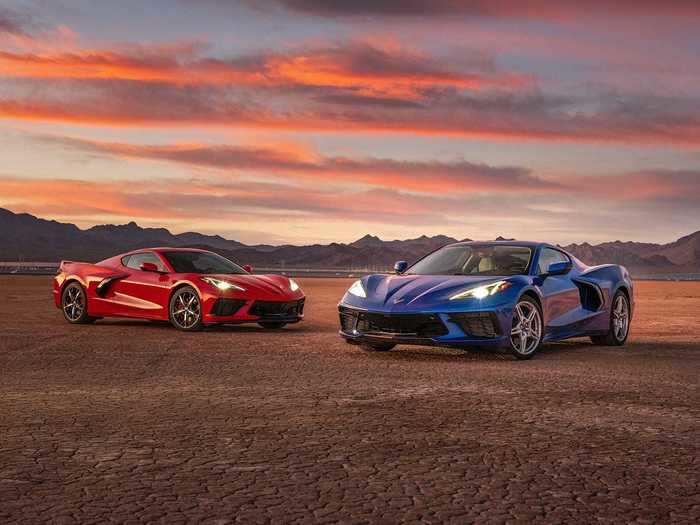
All eight generations of the Chevrolet Corvette.Chevrolet
Despite the generous offering of American muscle cars available to buyers today, there's only one considered to be America's sports car. That car is the Chevrolet Corvette.
The Corvette is currently in its eighth generation — and for the first time in its 67-year history, it finally has the setup that makes it competitive with the likes of the European supercars.
See, for the first seven generations, the Corvette stuck with a very traditional, front-engine layout, meaning its engine was located in front of the driver. Of course, there's nothing inherently wrong with a front-engine setup, but it's also a setup that very pedestrian cars like Toyota Camry also have.
In racing and with supercars, a mid-engine layout is generally much more preferred. A mid-engine layout is when the engine is located behind the driver and between the car's front and rear axles. Generally, mid-engine cars offer improved balance and handling because the heaviest part of the car — its engine — isn't located on only one end.
For decades, talk of a mid-engine Corvette flitted about the automotive industry. Years went by and nothing concrete ever came of it. The "mid-engine Corvette" sort of became an automotive tall tale.
Those rumors were finally laid to rest with the eight-generation Corvette, also known as the "C8" generation: the mid-engine Corvette, actualized. America's sports car had finally grown up and was ready to take on the global performance segment.
How did we get here? Why does the C8 matter? Dear reader, keep scrolling to find out.
Read the original article on Business Insider


This is because, according to Car and Driver, people just didn't buy enough manual C7 for GM to see a business case in offering manual C8s.





Finally.





Unfortunately, the Z06 also apparently had some overheating issues. A class-action lawsuit filed by Z06 owners claimed the car had a cooling system defect that forced it to go into limp mode after 15 minutes of track use.





But the base model was 60% stiffer than the performance-focused Z06 and ZR1 from the previous C6 generation.







Here's one in 2009.

(Now called WeatherTech Raceway Laguna Seca.)





It might have looked similar to regular C6s, but underneath, the Z06 was anything but. It had an aluminum frame, a magnesium engine cradle, and carbon-fiber front fenders, front wheel houses, and rear fenders.

Powered by a massive, naturally aspirated 7.0-liter LS7 V8, the Z06 produced 505 horsepower and 470 pound-feet of torque. It made a noise like metal being torn apart.




It wasn't a bad move.


Even by today's standards, that's a lot.

It had a top speed of more than 170 mph.





It had a 0.34 coefficient of drag, which was almost 25% less than the outgoing C3.


It was wider, had better tires, and, as noted by Road & Track, the LT5 5.7-liter V8 engine was unique to the ZR1. The LT5 was jointly developed with Lotus and boat-motor company Mercury Marine. The car made an impressive 380 horsepower and could hit 60 mph from a standstill in just 4.9 seconds.

Source: General Motors




A total of 58,307 Corvettes were sold in 1979, which, in 2013, was still the highest they'd ever been.

Source: Edmunds





It had industry-first "T-top" removable roof panels!






Sad.

The Corvette Sting Ray "Split Window" Coupe had a sort of "spine" that ran down the length of its body and manifested in a sectioned rear window.




You can see a documentary of the race here. It's pretty neat.


The C1 Corvette lasted from 1953 through 1962.

It went on to inspire the looks of the next-gen C2 Corvette.

Instead, in 1958, Chevrolet introduced a slight design refresh for dual headlights.

Ultimately, Arkus-Dontov was the one who pushed hardest for a mid-engine Corvette. During the 12 Hours of Sebring in 1957, a front-engine Corvette race car recorded a DNF — a "did not finish" in racing speak. What was more, the driver's feet were burning because of the engine's placement.
This race convinced Arkus-Dontov that the engine had to be behind the driver. It sparked years of mid-engine concepts and experiments that never panned out, but always seemed to be tantalizingly close production wise.

And the first generation established styling elements that would become staples of Corvettes to come: the iconic dual-round tail lights and cockpit-style interior.






It was a futuristic-looking sports car, with an engine mounted in the front. That layout would persevere for the next six decades.
 I spent $2,000 for 7 nights in a 179-square-foot room on one of the world's largest cruise ships. Take a look inside my cabin.
I spent $2,000 for 7 nights in a 179-square-foot room on one of the world's largest cruise ships. Take a look inside my cabin. Saudi Arabia wants China to help fund its struggling $500 billion Neom megaproject. Investors may not be too excited.
Saudi Arabia wants China to help fund its struggling $500 billion Neom megaproject. Investors may not be too excited. One of the world's only 5-star airlines seems to be considering asking business-class passengers to bring their own cutlery
One of the world's only 5-star airlines seems to be considering asking business-class passengers to bring their own cutlery From terrace to table: 8 Edible plants you can grow in your home
From terrace to table: 8 Edible plants you can grow in your home
 India fourth largest military spender globally in 2023: SIPRI report
India fourth largest military spender globally in 2023: SIPRI report
 New study forecasts high chance of record-breaking heat and humidity in India in the coming months
New study forecasts high chance of record-breaking heat and humidity in India in the coming months

Copyright © 2024. Times Internet Limited. All rights reserved.For reprint rights. Times Syndication Service.